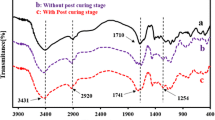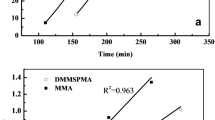Abstract
Novel crosslinking method was introduced for preparation of acrylic thickener microgels based on sodium acrylate and 2-acrylamido-2-methylpropane sulfonic acid (AMPS) through inverse emulsion polymerization (IEP). Usually multifunctional vinyl crosslinkers such as methylene bisacrylamide are used in preparation of microgels through IEP. In this paper, a novel crosslinking method was introduced for microgel preparation through IEP. Diglycidyl materials were used instead of vinyl crosslinkers for microgel preparation. The effect of two diglycidyl materials such as polyethylene glycol diglycidyl ether (PEGDGE) and ehylene glycol diglycidyl ether (EGDGE) was investigated as crosslinker in microgel synthesis. Acrylic microgels prepared through IEP can be used as a thickener for many industrial applications. The effects of parameters such as comonomer composition, drying temperature and crosslinker content on the thickening properties of microgels were investigated. According to the viscosity measurements, the microgel containing 12.5 % AMPS possessed the highest viscosity, while the lower viscosities were found to be observed for the microgels having the lower and higher percentages of AMPS. Moreover, the microgel containing AMPS showed the thickening properties over a wide range of pH and was nearly pH independent. Increasing drying temperature and amount of crosslinker led to enhance the crosslink density. The apparent viscosity was reduced and the storage modulus was increased in higher crosslink density. These microgels showed superior thickening properties in comparison to vinyl-crosslinked microgels, i.e., the thickening efficiency of PEGDGE-crosslinked microgels was significantly higher (about 500 %) than the conventional MBA-crosslinked microgels.










Similar content being viewed by others
References
Capek I (2005) On the hybride inverse-emulsion polymerization of acrylamide. Polym Plast Technol Eng 44:539–555
Ouyang L, Wang L, Schork FJ (2011) Synthesis and nucleation mechanism of inverse emulsion polymerization of acrylamide by RAFT polymerization: a comparative study. Polymer 52:63–67
Gelman RA, Harrington JC, Abe Vaynberg K (2008) Insight into the inversion mechanism of an inverse polymer emulsion. Langmuir 24:12727–12729
Bromberg L, Temchenko M, Hatton TA (2003) Smart microgel studies. Polyelectrolyte and drug-absorbing properties of microgels from polyether-modified poly(acrylic acid). Langmuir 19:8675–8684
Raemdonck K, Demeester J, De Smedt S (2009) Advanced nanogel engineering for drug delivery. Soft Matter 5:707–715
Kaneda I, Sogabe A, Nakajima H (2004) Water-swellable polyelectrolyte microgels polymerized in an inverse microemulsion using a nonionic surfactant. J Colloid Interface Sci 275:450–457
Islam MT, Rodriguez-Hornedo N, Ciotti S, Ackermann C (2004) Rheological characterization of topical carbomer gels neutralized to different pH. Pharm Res 21:1192–1199
Kabanov AV, Vinogradov SV (2009) Nanogels as pharmaceutical carriers: finite networks of infinite capabilities. Angew Chem Int Ed 48:5418–5429
Hernandez-Barajas J, Hunkeler DJ (1997) Inverse-emulsion polymerization of acrylamide using block copolymeric surfactants: mechanism, kinetics and modeling. Polymer 38:437–447
Willert M, Landfester K (2002) Amphiphilic copolymers from miniemulsified systems. Macromol Chem Phys 203:825–836
Candau F, Leong YS, Fitch RM (1985) Kinetic study of the polymerization of acrylamide in inverse microemulsion. J Polym Sci A Polym Chem 23:193–214
Kawaguchi H (2000) Functional polymer microspheres. Prog Polym Sci 25:1171–1210
Yao ZL, Grishkewich N, Tam KC (2013) Swelling and shear viscosity of stimuli-responsive colloidal systems. Soft Matter 9:5319–5335
Saunders BR, Laajam N, Daly E, Teow S, Hu X, Stepto R (2009) Microgels: from responsive polymer colloids to biomaterials. Adv Colloid Interface Sci 147–148:251–262
Klinger D, Landfester K (2012) Stimuli-responsive microgels for the loading and release of functional compounds: fundamental concepts and applications. Polymer 53:5209–5231
Sanson N, Rieger J (2010) Synthesis of nanogels/microgels by conventional and controlled radical crosslinking copolymerization. J Polym Chem 1:965–977
Echeverria C, Lopez D, Mijangos C (2009) UCST responsive microgels of poly(acrylamide-acrylic acid) copolymers: structure and viscoelastic properties. Macromolecules 42:9118–9123
Hennink WE, van Nostrum CF (2012) Novel crosslinking methods to design hydrogels. Adv Drug Deliv Rev 64:223–236
Nayak S, Lyon LA (2005) Soft nanotechnology with soft nanoparticles. Angew Chem Int Ed 44:7686–7708
Peppas NA, Hilt JZ, Khademhosseini A, Langer R (2006) Hydrogels in biology and medicine: from molecular principles to bionanotechnology. Adv Mater 18:1345–1360
Puig LJ, Sanchez-Diaz JC, Villacampa M, Mendizabal E, Puig JE, Aguiar A, Katime I (2001) Microstructured polyacrylamide hydrogels prepared via inverse microemulsion polymerization. J Colloid Interface Sci 235:278–282
Sahiner N, Godbey WT, McPherson GL, John VT (2006) Microgel, nanogel and hydrogel-hydrogel semi-IPN composites for biomedical applications: synthesis and characterization. Colloid Polym Sci 284:1121–1129
McAllister K, Sazani P, Adam M, Cho MJ, Rubinstien M, Samulski RJ, DeSimone JM (2002) Polymeric nanogels produced via inverse microemulsion polymerization as potential gene and antisense delivery agents. J Am Chem Soc 124:15198–15207
Kriwet B, Walter E, Kissel T (1998) Synthesis of bioadhesive poly(acrylic acid) nano- and microparticles using an inverse emulsion polymerization method for the entrapment of hydrophilic drug candidates. J Control Release 56:149–158
Marek SR, Conn CA, Peppas NA (2010) Cationic nanogels based on diethylaminoethyl methacrylate. Polymer 51:1237–1243
Ho BS, Tan BH, Tan JPK, Tam KC (2008) Inverse microemulsion polymerization of sterically stabilized polyampholyte microgels. Langmuir 24:7698–7703
Sung HW, Hsu CS, Lee YS, Lin DS (1996) Crosslinking characteristics of an epoxy-fixed porcine tendon: effects of pH, temperature and fixative concentration. J Biomed Mater Res 31:511–518
Ramazani-Harandi MJ, Zohuriaan-Mehr MJ, Yousefi AA, Ershad-Langroudi A, Kabiri K (2006) Rheological determination of the swollen gel strength of superabsorbent polymer hydrogels. Polym Test 25:470–474
Es-haghi H, Bouhendi H, Bagheri-Marandi G, Zohurian-Mehr MJ, Kabiri K (2010) Cross-linked poly(acrylic acid) microgels from precipitation polymerization. Polym Plast Technol Eng 49:1257–1264
Chamberlain EK, Rao MA (1999) Rheological properties of acid converted waxy maize starches in water and 90 % DMSO/10 % water. Carbohydr Polym 40:251–260
Hajighasem A, Kabiri K (2013) Cationic highly alcohol-swellable gels: synthesis and characterization. J Polym Res 20:1–9
Najafi V, Kabiri K, Ziaee F, Omidian H, Zohuriaan-Mehr MJ, Bouhendi H, Farhadnejad H (2012) Synthesis and characterization of alcogels based on ethylene glycol methyl ether methacrylate-vinyl phosphonic acid copolymers. J Polym Res 19:9866–9869
Kabiri K, Lashani S, Zohuriaan-Mehr MJ, Kheirabadi M (2011) Super alcohol-absorbent gels of sulfonic acid-contained poly(acrylic acid). J Polym Res 18:449–458
Pascault JP, Williams RJJ (2010) Epoxy polymers: new materials and innovations. Wiley-VCH, Weinheim
Es-haghi H, Bouhendi H, Bagheri Marandi G, Zohurian-Mehr MJ, Kabiri K (2013) An investigation into novel multifunctional cross-linkers effect on microgel prepared by precipitation polymerization. React Funct Polym 73:524–530
Kabiri K, Mirzadeh H, Zohuriaan-Mehr MJ (2008) Undesirable effects of heating on hydrogels. J Appl Polym Sci 110:3420–3430
Tong Z, Liu X (1994) Swelling equilibria and volume phase transition in hydrogels with strongly dissociating electrolytes. Macromolecules 27:844–848
Atta AM (2002) Swelling behaviors of polyelectrolyte hydrogels containing sulfonate groups. Polym Adv Technol 13:567–576
Li A, Wang A, Chen J (2004) Studies on poly(acrylic acid)/attapulgite superabsorbent composite. I. Synthesis and characterization. J Appl Polym Sci 92:1596–1603
Rosa F, Bordado J, Casquilho M (2002) Kinetics of water absorbency in AA/AMPS copolymers: applications of a diffusion-relaxation model. Polymer 43:63–70
Liu Y, Xie JJ, Zhang XY (2003) Synthesis and properties of the copolymer of acrylamide with 2-acrylamido-2-methylpropanesulfonic acid. J Appl Polym Sci 90:3481–3487
Bao Y, Ma J, Li N (2011) Synthesis and swelling behaviors of sodium carboxymethyl cellulose-g-poly(AA-co-AM-co-AMPS)/MMT superabsorbent hydrogel. Carbohydr Polym 84:76–82
Kabiri K, Azizi A, Zohuriaan-Mehr MJ, Bagheri Marandi G, Bouhendi H (2011) Poly(acrylic acid-sodium styrene sulfonate) organogels: preparation, characterization and alcohol superabsorbency. J Appl Polym Sci 119:2759–2769
Ramazani-Harandi MJ, Zohuriaan-Mehr MJ, Yousefi AA, Ershad-Langroudi A, Kabiri K (2009) Effects of structural variables on AUL and rheological behavior of SAP gels. J Appl Polym Sci 113:3676–3686
Jiang H, Su W, Mather PT, Bunning TJ (1999) Rheology of highly swollen chitosan/polyacrylate hydrogels. Polymer 40:4593–4602
Scott RA, Peppas NA (1999) Compositional effects on network structure of highly cross-linked copolymers of PEG-containing multiacrylates with acrylic acid. Macromolecules 32:6139–6148
Author information
Authors and Affiliations
Corresponding author
Rights and permissions
About this article
Cite this article
Hajighasem, A., Kabiri, K. Novel crosslinking method for preparation of acrylic thickener microgels through inverse emulsion polymerization. Iran Polym J 24, 1049–1056 (2015). https://doi.org/10.1007/s13726-015-0392-6
Received:
Accepted:
Published:
Issue Date:
DOI: https://doi.org/10.1007/s13726-015-0392-6




